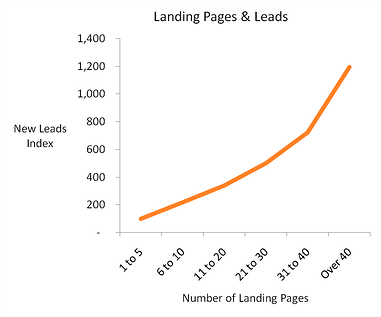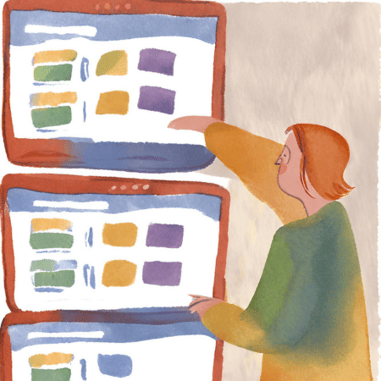Your website is like a digital storefront for your business, and just like a physical store, it's essential to convert visitors into leads and, eventually, customers. Lead conversions are the lifeblood of any successful online business. This falls under the Engage stage of the Flywheel model for transforming your company.
You're not alone if you need help to turn your website visitors into valuable leads. According to a study by Econsultancy, only 22% of businesses are satisfied with their conversion rates. This does not mean you should spend a lot of money on a tool (or a person) to help you fix your leaky funnel. Here are 15 proven strategies to help you increase lead conversions on your website.
1. Craft Compelling Landing Pages
 Landing pages are the first contact point for many website visitors. Make them count!
Landing pages are the first contact point for many website visitors. Make them count!
You can use persuasive headlines, engaging visuals, and concise copy that communicates the value proposition of your product or service.
HubSpot found that businesses with 31 to 40 landing pages get seven times more leads than those with only one to five. And it keeps growing from there! Companies with over 40 landing pages generated 12 times more leads than those with only 1 to 5 landing pages.
So, what are you waiting for? Do you need more leads? Strategy #1 is to generate more, better landing pages.
2. Implement A/B Testing
 A/B testing, sometimes "split testing," compares two webpage versions to see which performs better. You can identify what resonates best with your audience by experimenting with different elements. Each element can significantly impact the behavior of your target persona, so the best practice is to test only one variable at a time (you can also try multivariate testing, but we prefer A/B testing first).
A/B testing, sometimes "split testing," compares two webpage versions to see which performs better. You can identify what resonates best with your audience by experimenting with different elements. Each element can significantly impact the behavior of your target persona, so the best practice is to test only one variable at a time (you can also try multivariate testing, but we prefer A/B testing first).
Some elements you may want to test:
- All of your site’s CTAs (calls to action)
- Your site’s background color or mode (dark mode vs. light mode)
- The colors of your page elements
- Your images
- Content and its structure on your site
- Any on-page elements requiring user interaction
3. Optimize Page Load Speed
Speed matters. According to Think with Google's "The Need for Mobile Speed" report, 53% of mobile users abandon a site if it takes longer than 3 seconds to load. According to a recent study by Portent, a B2B site that loads in 1 second has a conversion rate that's three times higher than a site that loads in 5 seconds. Ensure your website loads swiftly for mobile and desktop visitors alike. Audit your site with PageSpeed Insights. Consider these optimizations:
- Limit HTTP requests
- Consider using a Content Delivery Network (CDN)
- Optimize image sizes
- Reduce redirects
- Minimize Time to First Byte
- Pre-load content with caching
- Combine CSS, JavaScript, and HTML Files
- Avoid 404s
- Load JavaScript asynchronously
- Reduce the number of plugins
- Minimize the number of fonts
- Add expires headers
4. Use Exit-Intent Pop-ups
The average time an average user spends on an average website is 54 seconds. But who wants to be average? Exit intent popups are a cost-effective lead conversion tool. They can help you:
- Keep visitors on your site for more extended periods
- Increase conversions
- Decrease cart abandonment rates
- Grow your email subscriber list
When visitors are about to leave your site, trigger an exit-intent pop-up with a compelling offer, such as a discount or a downloadable resource. OptinMonster reported a 200-600% increase in email signups using exit-intent pop-ups.
5. Leverage Social Proof
People tend to follow the crowd—showcase testimonials, reviews, and case studies on your website to build trust. According to BrightLocal, 87% of consumers read online reviews for local businesses, making them a powerful conversion tool. Moreover, their research found that 94% of users admit that positive reviews make them more likely to use a business, and 79% say they trust online reviews as much as personal recommendations from family or friends.
While the impact of online reviews varies significantly by industry (the highest are restaurants, hotels, medical/dental, and automotive), social proof is essential across the board.
In psychology, it is known as the bandwagon effect, the cognitive bias of doing what everyone else does. In lead conversion, it can translate to many things, like:
 Photos and testimonials from customers
Photos and testimonials from customers- Company names and logos, particularly from recognizable and well-respected brands
- Customer case studies
- Ratings or feedback from customers
- Reviews on third-party sites such as Yelp or Google
- Seals of approval from well-respected organizations
- Number of followers on social media platforms
- Sharing buttons with share counts and like counts
- Download and purchase counts
- Listing the number of customers
- Celebrity endorsements and shoutouts from influencers
- Testimonials from industry experts and expert social proof
6. Invest in High-Quality Content
Content is king, but not all kings are the same. And while content marketing, in general, can serve many purposes, content marketing for lead generation is unique. Remember that with lead conversion, we are in the Engage stage of the marketing flywheel, so we are not looking for the "fluffier" ToFu (Top of Funnel) content that attracts visitors. Instead, we aim to provide value and help solve problems. We need content that compels them to take action (in this case, the action is leaving their lead info). So, be smart about the content you create for this purpose and ALWAYS include a clear next action step (CTA).
The trend these days is toward video content. According to The State of Video Marketing 2022 by Wyzowl, video has helped 86% of marketers generate more leads. You can create tutorials and advice videos on YouTube, short-form explainers on TikTok, or in-line videos to be used on your landing pages or even inserted into your blog posts.
There are other content types to test for lead conversion. For example, you will want gated content offers like pillar pages, ebooks, research reports, white papers, or webinars. Make sure the content you create is hyper-targeted for your personas and their pain points so that they will find enough value to warrant leaving their valuable contact info.
7. Optimize for Mobile
Mobile optimization is no longer optional. Google's mobile-first indexing means your site's mobile experience directly impacts search rankings. Please make sure your website is responsive and offers a seamless mobile experience. Similar to content, mobile optimization has different goals: it can be great for SEO and attracting visitors to your site, but to convert leads, you will need to optimize:
- Use click-to-call (or text) links.
- Avoid pop-ups at all costs (but if you must -- like for cookie consent -- ensure your popups are optimized for the mobile user experience).
- Compress images -- and content! While reducing the size of images improves load speed, reducing the volume of the words on your page will improve your user's sanity.
8. Personalize User Experience
Use data and analytics to tailor content and offers to individual users. According to Evergage, 88% of marketers saw a measurable improvement in their results due to personalization. Personalization allows you to tailor content, product recommendations, and offers to each user's interests and preferences. Users who see content that resonates with them are more likely to engage with it and take desired actions (such as purchasing or signing up for a newsletter).
Personalization reduces friction from your flywheel and simplifies the user journey by presenting options and information directly relevant to their needs. This reduces the cognitive load (and decision fatigue) associated with searching for relevant content or products, making it easier for users to convert.
Personalization creates a more engaging and interactive user experience. When users feel that a website understands their needs and preferences, they are likelier to spend more time on the site, explore additional pages, and engage with its features. Personalization can enhance trust by showing that you value and understand your users. When users receive personalized recommendations or content, they are more likely to trust your brand and feel that their interactions with your website are tailored to their needs.
9. Simplify Forms
Long and complicated forms can be a significant turnoff. Simplify the process by asking for only essential information. According to Formstack, reducing form fields from 11 to 4 can increase conversions by 120%. Unbounce generally says forms with only three fields have a 25% conversion rate, while those with six or more fields have a 15% conversion rate. Some more interesting insights:
- Asking for age reduces the conversion rate by 3%
- Asking for a phone number reduces the conversion rate by 5%
- Asking for city and state reduces conversion rate by 2%
- Asking for street address reduces the conversion rate by 4%
When Expedia simplified its forms by eliminating only ONE field (company name), the resulting conversion rate increase resulted in $12 million in additional profits.
10. Create Urgency and Scarcity
When you incorporate urgency or scarcity into your calls to action, you prompt users to convert sooner. Phrases like "limited time offer" or "only a few spots left" can prompt visitors to convert.
Urgency and scarcity are psychological principles that can be leveraged to encourage website visitors to take action and convert into leads or customers. Here's an explanation of the psychology behind these concepts:
Urgency
Urgency involves creating a sense of immediate importance or time pressure. It implies that an opportunity or benefit is only available for a limited time, and if the user doesn't act quickly, they may miss out. Urgency taps into our natural instincts for survival and the fear of missing out (FOMO). When people perceive something as urgent, their brain's "fight or flight" response can kick in. For example, phrases like "Act now" or countdown timers on a website can create a sense of urgency. People are more likely to convert when they believe they must make a decision promptly.
Scarcity
Scarcity involves highlighting that a product or opportunity is in short supply or limited in quantity. It suggests that the item is rare and may not be available for long. Scarcity triggers the fear of loss. People may perceive something as more valuable and desirable when they believe it is scarce. This is due to the idea that rare or limited items often hold higher value in our minds. For example, phrases like "Only a few left in stock" or "Limited supply" convey scarcity. When users feel that a product or opportunity is scarce, they are more inclined to convert to ensure they don't miss out on something valuable.
Together, urgency and scarcity tap into basic human emotions and instincts. They create a sense of importance and value, prompting individuals to take action quickly. However, it's important to use these psychological tactics ethically and honestly on websites. Misleading or false claims of urgency and scarcity can erode trust and harm your brand's reputation. When implemented authentically, these tactics can be effective tools to boost conversions by aligning with basic human psychological responses to time-sensitive situations and perceived rarity.
11. Provide Live Chat Support
Live chat offers real-time assistance to visitors, answering questions and overcoming objections. According to Kayako, websites with live chat have a 48% higher conversion rate than those without. Many benefits of Live Chat create this substantial bump in conversions.
- Immediate Assistance: Live chat allows website visitors to get immediate answers to their questions or assistance with their concerns. This quick response can prevent potential customers from leaving the site out of frustration or confusion, increasing the chances of conversion.
 Personalized Support: Live chat enables real-time, one-on-one interactions. Customer support agents can provide personalized assistance, product recommendations, or solutions tailored to each visitor's specific needs and preferences. This personal touch can enhance the customer experience and build trust.
Personalized Support: Live chat enables real-time, one-on-one interactions. Customer support agents can provide personalized assistance, product recommendations, or solutions tailored to each visitor's specific needs and preferences. This personal touch can enhance the customer experience and build trust.- Real-Time Problem Solving: If visitors encounter an issue or have a question, they can resolve it instantly through live chat. This can prevent potential customers from deferring their decision to a later time or abandoning the task they set out to do.
- Building Trust: Knowing that there is a real person available for assistance can instill confidence in visitors. It demonstrates that the business is attentive to customer needs and is committed to providing excellent service, which can build trust and encourage conversions.
Live chat on websites enhances the user experience by providing immediate, personalized, and real-time assistance. By addressing visitor concerns, reducing barriers to conversion, and building trust, live chat can lead to higher conversion rates and improved customer satisfaction, ultimately benefiting your bottom line.
It is not one(won)-and-done
Boosting lead conversions on your website is an ongoing process that requires dedication and a willingness to adapt. By implementing even just some of these 11 proven strategies, you can create a more engaging, persuasive, and user-friendly website that converts visitors into valuable leads. Remember, conversion optimization is not a one-size-fits-all approach, so be prepared to experiment and fine-tune your strategies based on your unique audience and goals. With patience and persistence, you can watch your lead conversions soar, and your business thrive in the digital landscape.
 Landing pages are the first contact point for many website visitors. Make them count!
Landing pages are the first contact point for many website visitors. Make them count!  A/B testing, sometimes "split testing," compares two webpage versions to see which performs better. You can identify what resonates best with your audience by experimenting with different elements. Each element can significantly impact the behavior of your target persona, so the best practice is to test only one variable at a time (you can also try multivariate testing, but we prefer A/B testing first).
A/B testing, sometimes "split testing," compares two webpage versions to see which performs better. You can identify what resonates best with your audience by experimenting with different elements. Each element can significantly impact the behavior of your target persona, so the best practice is to test only one variable at a time (you can also try multivariate testing, but we prefer A/B testing first). Photos and testimonials from customers
Photos and testimonials from customers Personalized Support: Live chat enables real-time, one-on-one interactions. Customer support agents can provide personalized assistance, product recommendations, or solutions tailored to each visitor's specific needs and preferences. This personal touch can enhance the customer experience and build trust.
Personalized Support: Live chat enables real-time, one-on-one interactions. Customer support agents can provide personalized assistance, product recommendations, or solutions tailored to each visitor's specific needs and preferences. This personal touch can enhance the customer experience and build trust.


